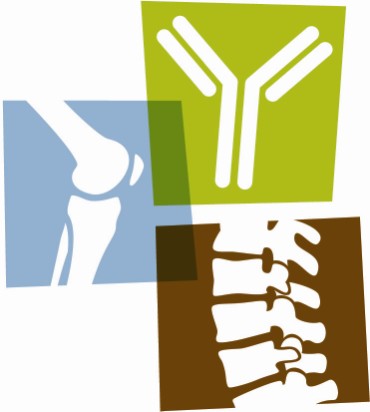
Ccao.net


COLORADO BONE &
VOLUME I, ISSUE 1
JOINT QUARTERLY
A p ubli ca ti on of Col orad o Ce n t e r for A rt h ri t i s & Ost e op orosi s, PL L C
Cop yri gh t 2 01 0
Inside this issue:
Welcome to the inaugural lieve strongly that the best future topics. You may
issue of the Colorado Bone medical care for this chal-
contact us by e-mail at
Immunosuppressed
and Joint Quarterly, pub-
lenging group of patients can [email protected] or cal
lished by Colorado Center only come through ongoing (720) 494-4700. More for Arthritis and Osteoporo-
cooperation and col-
information about our
Reclast and Denosumab 3
sis. The fields of rheumatol-
laboration between rheuma-
practice can be found at
ogy and metabolic bone tology specialists and pri-
www.ccao.net. We are al-
disease have seen dramatic mary care providers. The ways happy to speak with
advances in recent years. It is newsletter will focus on par-
our col eagues and would be
hard enough for those of us ticular areas that will affect happy to discuss a case over
within the field to keep up your ability to evaluate the phone, to help you de-
with developments, much patients with musculoskeletal termine whether a patient less those of you outside of complaints, decide when to would benefit from consul-
the field! Thus, we have de-
refer to a rheumatologist, tation with one of our
signed this newsletter with and continue to provide ef-
primary care providers and fective primary care to gists, or to coordinate the
other non-rheumatologists in patients who are being care of a mutual patient. mind.
treated for rheumatic dis-
Please let us know what we
can do to serve you and
Our goal is to update you on
your patients better.
specific developments that We hope this information will affect your ability to care will be a valuable resource to Jeffrey D. Perkins, MD PhD for your patients with you. Please give us your Clinical Director
diseases of bone, joint and feedback on this issue, as
connective tissue. We be-
wel as any suggestions for
CARDIOVASCULAR RISK IN RHEUMATIC DISEASE by Joseph R. Lutt, MD
Inflammatory arthritis as a
tion is comparable to that of type 2 dia-
betes mel itus.3
matory arthritis
CV risk factor
Compared with age-matched controls,
Risk reduction: arthritis treat-
significantly over
the risk of dying is twofold higher for
the past decade.
patients with rheumatoid arthritis (RA).1
With this in mind, the approach to pa-
As we have moved to the earlier use of
The data are less robust with regards to
tients with inflammatory arthritis should
oral and biological disease-modifying anti-
psoriatic arthritis and ankylosing spondy-
now focus not only on their joint com-
rheumatic drugs (DMARDs), the preven-
litis, but it appears that the mortality risk
plaints but also on cardiovascular health.
tion of joint destruction and disability has
for those conditions is 1.5 to 1.9 times
become a reality. It is also becoming ap-
greater.2 The excess deaths are over-
(Continued on page 2)
parent that these medications may have
whelmingly due to cardiovascular disease.
benefits beyond the joints, especial y with
Traditional risk factors probably occur
".the cardiovascular risk
regards to heart disease and survival. The
more frequently in these diseases but
fol owing is a brief summary of what is
seem to account for only part of the
of the RA population is
known about the cardiovascular disease
increased risk. The inflammatory arthritis
risk in patients with inflammatory arthri-
itself appears to be an independent risk
comparable to that of
factor for cardiovascular disease. In fact,
tis as wel as the effects of treatment.
the cardiovascular risk of the RA popula-
type 2 diabetes mellitus."

CARDIOVASCULAR RISK
(Continued from page 1)
Risk reduction: traditional
of cardiovascular risk modification during
A recent meta-analysis of RA trials re-
risk factors
our visit but will defer the management
vealed that the rate of al -cause mortality
of hypertension and dyslipidemia to pri-
It is assumed that modification of tradi-
was reduced by 50% and cardiovascular
mary care providers. We hope that by
tional risk factors and the addition of
death by 70% in patients treated with
working with you to target both the ar-
low-dose aspirin would have benefits in
methotrexate compared with those not
thritis and cardiovascular disease, we wil
arthritis patients similar to that seen with
treated with methotrexate.4 The rates of
improve the long-term outcome for the
the general population, but no formal
myocardial infarction and hospitalization
studies specifical y with inflammatory
vast majority of our patients.
for heart failure were also reduced by
arthritis have been conducted. We
1. Avina-Zubieta JA, et al. Arthritis Rheum
approximately 20%. Another study con-
would suggest using an approach similar
2008;59:1690-97.
firmed the benefit of the older tumor
to that of the diabetic population due to
necrosis factor inhibitors (Enbrel, Remi-
2. Peters MJ, et al. Semin Arthritis Rheum
the comparable cardiovascular risk. Stat-
cade, and Humira) as wel , with a reduc-
ins, ACE inhibitors, and ARBs may be
tion in the incidence of myocardial infarc-
especial y helpful due to their favorable
3. Peters MJ, et al. Arthritis Rheum
tion.5 It is not clear whether these bene-
effects on inflammation and endothelial
2009;61:1571-79.
fits are due to an improvement in tradi-
tional risk factors or reduction in the
4. Westlake SL, et al. Rheumatology
effect of systemic inflammation on the
In the end, we share a common goal with
2010;49:295-307.
vasculature. While these DMARDs are
our patients' primary care providers: to
5. Dixon WG, et al. Arthritis Rheum
started with the arthritis in mind, the
provide the best care for our patients.
long-term cardiovascular and survival
We wil typical y discuss the importance
2007;56:2905-12.
benefits are certainly encouraging.
IMMUNIZATION IN IMMUNOSUPPRESSED PATIENTS by Nguyet-Anh (Theresa) Tran, MD
nasal flu vaccine is a live attenuated virus,
tors include a history of multiple sexual
tients with auto-
this method of immunization should not
partners in the past six months, house-
be used in immunosuppressed patients or
hold contacts with hepatitis B, IV drug
in household contacts of these patients.1
abuse, and being a healthcare worker.
suppressive medi-cations that may
Pneumovax
make them susceptible to various infec-
Al immunocompromised patients, re-
Meningococcal disease is a devastating
tions. Patients requiring chronic predni-
gardless of age, should receive the pneu-
infection that primarily affects children
sone, disease modifying drugs (e.g., meth-
mococcal polysaccharide vaccine (PCV7
and young adults. General recommenda-
otrexate, Imuran, etc.), and biologic
for children and PPSV23 for adults). It is
tions are to immunize al children aged 2
agents (e.g., Enbrel, Humira, Rituxan, etc.),
further recommended that immunocom-
to 10 years and adolescents aged 11 to
should al have current immunizations. promised patients receive a single revac-
18 years. Adults with increased risk
The American Col ege of Rheumatology
cination if it has been more than five
(including military recruits, microbiolo-
(ACR) and Centers for Disease Control
years since the first dose.
gists exposed to N. meningitides, individu-
(CDC) have developed guidelines for
als with asplenia, and travelers to en-
routine immunization in these patients.
Viral Hepatitis
demic areas) should also be considered
Several disease modifying drugs
for immunization. For patients with rheu-
Influenza
(methotrexate, leflunomide, and some
matic disease, it is recommended that
Al immunosuppressed patients should be
biologic agents) pose a significant risk of
those with complement component defi-
vaccinated against influenza every fal ,
hepatotoxicity. In those patients who
ciencies (C3, properdin, Factor D, late
regardless of age. In the 2009-2010 flu
are at high risk, it is recommended that
complement components) also be vacci-
season, recommendations included both
they receive the Hepatitis B vaccine prior
seasonal and H1N1 immunization. Since
to starting these medications. Risk fac-
(Continued on page 3)

(Continued from page 2)
prior to travel outside the U.S, with the
are often more susceptible to infectious
Live Virus Vaccines
exception that they should not receive
diseases and are more likely to develop
live attenuated vaccines. Specifical y, im-
serious complications from infection,
The general rule is to avoid live virus
munosuppressed patients should not re-
appropriate immunization is especial y
vaccines in immunocompromised pa-
ceive the yellow fever vaccine and the
important in this population. Assuring
tients. This includes the MMR vaccine
typhoid vaccine. Hepatitis A and B vac-
that these patients have updated vaccina-
and the varicella and Herpes zoster vac-
cines are inactivated, and are therefore
tions is an important step in preventing
cinations. More recent guidance from the
serious infections and complications that
Advisory Committee on Immunization
safe for immunocompromised individuals.
may lead to worsening morbidity and
Practices more specifical y indicates that it is safe to give the zoster vaccination to
mortality in these vulnerable individuals.
".avoid live virus vaccines
patients being treated with meth-
in immunocompromised
otrexate, leflunomide, sulfasalazine and
low-dose prednisone(<20 mg/d).2,3 The
patients."
shingles vaccine is stil not recommended
for patients on biologic DMARDS (Enbrel, Humira, Remicade, Orencia,
Do Immunizations Worsen
2. MMWR 57:RR-5, June 6, 2008
Rituxan, Kineret, Actemra) or on chronic
doses of prednisone higher than 20 mg
Autoimmune Disease?
To date, there is no evidence that vacci-
nating patients with autoimmune rheu-
Vaccines for Travel
matic disease worsens or exacerbates
Unless otherwise noted, the recommenda-
In general, immunosuppressed patients
tions in this article can be found at the Cen-
should receive recommended vaccines
ters for Disease Control and Prevention Web
Since patients with autoimmune diseases
site: www.cdc.gov.
RECLAST & DENOSUMAB: NEW OPTIONS FOR OSTEOPOROSIS by Heather L. Kramm, MD. Director of Bone Health
include the treatment and prevention
at increased risk for mandibular osteone-
approach remains
(given every 2 years if osteopenic) of
crosis, patients limited by myalgia or
prevention, there
osteoporosis in postmenopausal women,
(Continued on page 4)
osteoporosis in men, treatment of gluco-
corticoid –induced osteoporosis, preven-
tion of new clinical fractures in patients
Two alternatives to oral
who have recently had a low-trauma hip
fracture and Paget's disease.
bisphosphonates
The most common side effect of Reclast
The advent of annual intravenous Re-
is a self-limited flu-like reaction. Jaw os-
clast (zolendronic acid) has improved
teonecrosis and subtrochanteric frac-
compliance with therapy and offers a
IV bisphosphonate
tures are extremely rare. Reports of an
better alternative to oral bisphospho-
Consider when oral
association between bisphosphonate use
nates when patients have limiting GERD,
and atrial fibril ation have been conflicting
bisphosphonate contraindicated
other esophageal or GI comorbidity or
and remain unsupported by meta-
or not tolerated
intolerance. The HORIZON study with almost 8,000 patients found that yearly
Denosumab
5mg IV Reclast reduced the incidence of
Denosumab
vertebral and nonvertebral fractures, and
There stil remains great need for a treat-
Given SQ q. 6 months
the cumulative risk of hip fractures by
ment class other than bisphosphonates.
Presently under development
40% during a 3 year period .1
Forteo use is limited by cost and its re-
Consider when bisphosphonates
FDA approved indications for Reclast
quired daily SQ administration. Patients
fail or are contra-indicated

V O LUME 1, I SSUE 1
RECLAST AND DENOSUMAB
(Continued from page 3)
subcutaneous injection every 6 months
For patients with intolerance, contraindi-
bone pain, or patients who have declining
for 36 months. Denosumab reduced the
cation or failure of oral bisphosphonates,
BMD or fracture while taking bisphos-
risk of vertebral and nonvertebral frac-
Reclast is an effective parenteral alterna-
phonates need another option. The FDA
tures, as wel as hip fractures with a rela-
tive. In the near future, denosumab
is currently reviewing denosumab
tive decrease of 40%.2 The indications for
should offer another effective choice for
(expected brand name Prolia), and ap-
which Amgen is seeking FDA approval
this chal enging subset of osteoporotic
proval is expected in the near future. are treatment and prevention of post-
Denosumab is a human antibody to
menopausal osteoporosis in women and
RANKL, which controls osteoclast differ-
treatment and prevention of bone loss in
1. Black D, et al. New Engl J Med
entiation, activation and survival. In the
patients undergoing hormone ablation
2007;356:1809-1822.
FREEDOM trial with almost 8000 pa-
therapy for either prostate or breast
2. Cummings SR, et al. New Engl J Med
tients, denosumab was administered as a
2009;361:756-765.
ANTI-CCP: A NEW DIAGNOSTIC TOOL FOR RHEUMATOID ARTHRITIS by Jeffrey D. Perkins, MD PhD, Clinical Director
has been widely available in commercial
RA as a similar patient with a positive RF.
few years, a new
labs for about the last 5 years.
Anti-CCP is occasional y present in other
disease states (including lupus, psoriatic
arthritis or tuberculosis infection). How-
arthritis (RA) has
"Anti-CCP antibodies are
ever, highly positive anti-CCP levels are
rare in other conditions.
highly specific for RA.
the anti-CCP [cyclic citrul inated peptide]
Anti-CCP antibodies have been shown to
Recent studies indicate a
antibody (also known as anti-citrul ine
be present several years before the clini-
antibody). This laboratory test, readily
specificity of about 95%.
cal onset of rheumatoid arthritis. There
available in al commercial labs, comple-
is circumstantial evidence that anti-
A patient with a positive
ments the older rheumatoid factor (RF)
citrul ine antibodies are pathogenic in RA
test in the evaluation of patients with
instead of being simply a marker of dis-
anti-CCP is almost 3 times
ease (in contrast to RF), and this is an
inflammatory arthritis.
as likely to actually have
area of active research. Even though
Background
positive anti-CCP antibodies may be able
RA as a similar patient
Citrul ine is a natural y-occurring amino
to predict individuals at risk for develop-
acid that is produced by post-
ing RA, in absence of preventative treat-
with a positive RF."
translational modification of arginine by
ments for RA there is no clinical utility in
peptidyl arginine deaminase (PAD).
identifying these patients in a pre-clinical
Citrul ination of proteins can occur in
Anti-CCP in RA
normal tissues, but is increased in pro-
Anti-CCP antibodies are highly specific
Anti-CCP antibodies are more likely than
teins such as fibrinogen and col agen in
for RA. Recent studies indicate a specific-
RF to present in early symptomatic dis-
rheumatoid joints. Antibodies directed
ity of about 95% (compared to 85% for
ease, prior to a patient meeting current
against citrul inated peptides have been
rheumatoid factor), with even higher
classification criteria for RA. In these
known to occur in patients with rheuma-
specificities with highly positive tests. The
undifferentiated arthritis patients, the
toid arthritis several years before the
sensitivity of anti-CCP for RA (67%) is
presence of anti-CCP is a strong predic-
onset of arthritis. The development of
about the same as for rheumatoid factor
tor of progression to RA.2
the anti-CCP assay has al owed these
(69%). The increased specificity of the
antibodies to be detected quickly and
anti-CCP test results in a positive likeli-
Anti-CCP antibodies have also been
accurately by an automated enzyme-
hood ratio of 12.46 (compared with 4.86
shown to be a strong predictor of persis-
linked laboratory test, thus al owing the
for rheumatoid factor).1 This means that
tent, aggressive, joint damaging disease in
commercial availability of anti-citrul ine
a patient with a positive anti-CCP is al-
RA patients. One study of patients with
antibody detection. The anti-CCP assay
most 3 times more likely to actual y have
(Continued on page 5)
ANTI-CCP ANTIBODIES
(Continued from page 4)
toid factor is negative. Another is a pa-
body testing should never dissuade you
early RA shows that, of al the risk
tient with a positive RF, but without con-
from referring a patient in whom your
factors studied, a positive anti-CCP
vincing clinical evidence of RA. Final y,
clinical suspicion is high. With the highly
was the strongest predictor of persis-
the anti-CCP status of a patient with
effective treatments available now for
tent erosive disease.3 Thus, patients
early RA can help to risk-stratify the pa-
RA, prompt referral to a rheumatologist
with a positive anti-CCP antibody
tient, which can in turn guide the aggres-
is more important than ever to minimize
should be strongly considered for
siveness of therapy.
the chance of joint damage and resultant
aggressive disease-modifying antirheu-
matic drug (DMARD) treatment as
It is important to keep in mind that nei-
early after the onset of symptoms as
ther the RF nor the anti-CCP are useful
As always, don't hesitate to give us a cal
in fol owing disease activity – they are
if you have a question about interpreting
only useful for initial diagnosis. Tests such
a patient's test results or determining if
When to Check
as sedimentation rate and C-reactive
they are an appropriate patient for rheu-
So, when should you check an anti-
protein are more useful to fol ow disease
matology consultation.
CCP? I do not recommend this test as
activity in diagnosed rheumatoid arthritis.
1. Nishimura K, et al. Ann Int Med 2007;
a general screening test for patients
There is a significant minority of patients
with joint pain. However, it can pro-
with rheumatoid arthritis who have nei-
vide valuable information in at least
ther a positive rheumatoid factor nor a
2. van Gaalen FA, et al., Arthritis Rheum
three situations. One such situation is
positive anti-CCP ("seronegative" rheu-
2004; 50:709-715.
a patient in whom you are suspicious
matoid arthritis). Thus, negative autoanti-
3. Visser H, et al., Arthritis Rheum 2002;
of early RA but in whom the rheuma-
Berger, PA-C, offer a ful range of
CCAO Offices
rheumatology and bone health services.
Longmont
Dr. Shiraz Moinuddin will be joining our
Colorado Center for Arthritis and
practice in October 2010.
1551 Professional Lane
Osteoporosis has provided expert,
Services offered by CCAO include
compassionate care for patients with
consultation and disease management
Longmont, CO 80501
arthritis, autoimmune connective tissue
services in the areas of rheumatology and
disease and osteoporosis since 1998 to
metabolic bone disease, and infusion
the residents of Boulder County, with
centers at al of our locations. In
offices in Boulder and Longmont. In
addition, we offer bone densitometry
3434 47th Street
2009, we undertook a significant
(DXA) at our Longmont location.
expansion in order to improve access to rheumatology and metabolic bone
We strive to serve our patients and
Boulder, CO 80301
services for residents of the northern
referring physicians by providing prompt
and western Denver metropolitan area.
and convenient access to our services.
Louisville
We are presently serving this region
Patients can generally be seen for an initial
from our temporary office in Louisvil e,
consultation in 1 to 2 weeks and urgent
80 Health Park Drive
while preparing to open our permanent
cases can be accommodated in 1 to 2
Broomfield facility, near the intersection
business days. Our physicians are readily
Louisville, CO 80027
of U.S. 36 and U.S. 287, in the summer
available by phone to give advice to our
col eagues in the areas of rheumatology
and metabolic bone disease.
Phone: (720) 494-4700
Drs. Jeff Perkins, Heather Kramm, Joe Lutt and Theresa Tran are al Board
Please visit us on line at www.ccao.net,
Fax: (720) 494-4706
Certified in internal medicine and
or e-mail us at [email protected]. We'd
E-mail: [email protected]
rheumatology. They, along with Sharin
love to hear from you!
Web: www.ccao.net
Source: http://www.ccao.net/news/wp-content/uploads/2012/12/CCAO-Provider-Newsletter-Spring-2010.pdf
Internet Radio Guide Favorite sites from the world of Internet radio Take a tour of some favorite Internet radio sites from the experts at Linux New Media. BY MATHIAS HUBER, MARCEL HILZINGER, KRISTIAN KISSLING, OLIVER FROMMEL, AND PETER KREUSSEL We have some very musical au- "Downtown Soulville," and the breath- short, has a great Internet department. I
Venom Peptides and their Mimetics as Potential DrugsOren Bogin, Ph.D. Venomous creatures have a sophisticated mechanism for prey capture which includes a vast array of biologically-active compounds, such as enzymes, proteins, peptides and small molecular weight compounds. These substances target an immense number of receptors and membrane proteins with high affinity, selectivity and potency, and can serve as potential drugs or scaffolds for drug design.









